Combat-style Rugged Sole Buckle Detailed Mid-calf Fashion Boots
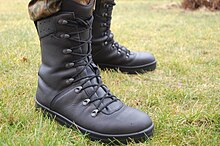

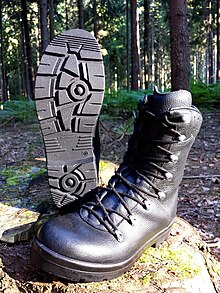
Gainsay boots are military boots designed to be worn by soldiers during combat or combat training, as opposed to during parades and other formalism duties. Modern gainsay boots are designed to provide a combination of grip, ankle stability, and foot protection suitable for a rugged environment. They are traditionally made of hardened and sometimes waterproofed leather. Today, many gainsay boots incorporate technologies originating in civilian hiking boots, such as Gore-Tex nylon side panels, which better ventilation and comfort. They are also often specialized for certain climates and conditions, such as jungle boots, desert boots, and cold weather boots as well equally specific uses, such as tanker boots and jump boots.[1] [two] [3]
History [edit]
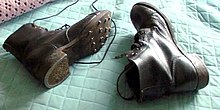
Early [edit]
Classical era [edit]
The legionnaires of the Roman Empire[four] wore hobnail boots, called caligae. Past the belatedly 1st century the army began to transition into an enclosed boot called calceus; calcei offered more protection and warmth than the caligae. They speedily became a staple in both Roman armed services and civilian dress.[v]
England and U.k. [edit]
During the English Civil State of war, each soldier of the New Model Army was issued three shoes or ankle boots. After every march, the soldier would change them around to ensure they received even wear. Following the Restoration, shoes and uniforms followed the civilian pattern: shoes with buckles were used by virtually armies from 1660 until around 1800. Hessian boots were used by cavalry from the 18th century until Earth War I.
Late in the Napoleonic Wars, the British ground forces began issuing ankle boots that replaced the buckle shoes. These types of boots remained in employ throughout the 19th century and were used in conflicts including the Crimean War (1853–1856), First Zulu State of war (1879), and First Boer State of war (1880–1881).
These in turn were replaced by ammunition boots, which were used in a variety of like blueprint patterns from the late 1880s until the belatedly 1960s. The "George Boots" worn with the Officers' dress uniform and mess dress are similar, but they lack the leather counter (heel cap), the toe instance (toe-cap) and omit the hobnails, and the steel heel and toe plates.
United States [edit]
Infantry regiments of the US military were equipped with calf-loftier boots in the State of war of 1812. From the 1820s until before the American Ceremonious War soldiers were issued talocrural joint-high boots, which were made on straight lasts. At that place was no "left" or "right" boot; instead, they shaped themselves to the wearer'south feet over time. As a result, these boots were very uncomfortable until cleaved in and often resulted in blisters. They were replaced in 1858 with an improved version generally known as Jeff Davis boots subsequently Jefferson Davis, the Secretary of War who re-equipped the ground forces in the 1850s. These were used until the 1880s.
21st Century – present [edit]
Australia [edit]
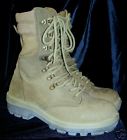
The Australian Terra Combat Boot.
Since 2000, the Australian Defense force, primarily uses the Redback Terra Combat Boot as a replacement for the Vietnam War-era General Purpose combat boots. It was given a limited number of tests in 1999, and was later distributed in 2000. Despite the boot's general aptitude for the tasks which the ADF had first put it in place for, it still had major flaws. 90% of all negative feedback from soldiers was near its inappropriate sizing, having only 43 different sizes. Many also claimed that its sole would rot under worst-case tropical circumstances. Various military personnel accept also used Rossi boots.[6]
In mid 2013 a boot trial was undertaken by the ADF to find a replacement for the issued Redback Gainsay Boot. Boots trialled included updated versions of the Redback Kicking as well as diverse off the shelf boots. At the determination of the trial the Danner TFX 8 was selected as the new ADF gainsay boots: they were comfortable in hot weather and provided practiced support. However these were found to fail prematurely and were never issued on a big calibration.
As a result, Redback were tasked with once again providing a range of gainsay boots to the ADF including a Full general Purpose boot, a Jungle Fashion boot and a Flame Resistant boot. These boots are existence issued on a very limited basis and are currently undergoing express testing. All the same early reports are non favourable with complaints of declining eyelets and lack of water resistance. Danners are still being retained as a 'Desert' boot or for those who don't fit the current boot.
Equally of Dec 2017 the Redback Terra style gainsay boot is however the standard upshot combat boot.
Argentina [edit]
In the early 20th century, Argentine soldiers wore hobnail boots with leather gaiters too as jackboots. The gainsay boots worn during the Falklands War came with durable stitched rubber soles. These boots continue to be worn today in addition to the afterwards design with "EA" stamped on the leg.
Kingdom of belgium [edit]
Belgian combat boots are marked by the abbreviation "ABL" (Armée Belge / Belgisch Leger), i.e. "Belgian military machine" in French and Dutch languages. The soles of Belgian combat boots have dissimilar markings, according to the soles manufacturers: Rugak, Rubex and Solidor (models of 1970-southward). Leather uppers have markings of "GESKA" ("Geska" NV) or "ARWY NV". Belgian Combats of the years 1970-90s come with stitched safety soles.[seven] Later blueprint fabricated by Urban Trunk Protection International and come with British type "tyre tread" soles.
France [edit]

Brand new Mle 1965 combat boots made of shined black leather with directly molded soles.
Gainsay boots of the French army are nicknamed "rangers" because of their similarity to the 1000 43 American model. Since the end of World War 2, iii models take been manufactured. The start model was based on the 1952 combat ankle-boots on which a leather high-top cuff with two buckles were added. It was made of sturdy but very stiff brown colored cowhide leather. It was called "brodequin à jambière attenante Mle 1952" and was widely distributed from 1956 on, in priority to airborne troops engaged in Algeria. In 1961, a simplified version was introduced, the boot and the leather cuff being made in one piece. In 1965 a new version of the 1961 model was introduced made of shined black grained leather more flexible than the original ane. Their soles were of a directly molded blazon. In 1986 a transitory model with laces and enhanced waterproofing was experimented with nether the designation "combat boots model F 2" but was not adopted. The get-go ii models had to exist blackened with colored grease and shoe smooth. They were issued to French soldiers; including Foreign legionnaires, until the showtime of the 1990s, and so were kept in shop in example of conflict. A lot of them have been released on the market after the gendarmerie dropped the territorial defense mission at the beginning of the 21st Century. A winter model, with laces and a Gore-Tex lining was introduced in 1998. The 3rd model and a winter model are still in service in the French ground forces but are progressively existence replaced in operation by more than modern Meindl blazon boots.
By the finish of the 2000s, following the FÉLIN equipment program, the venerable Mle 1965 blueprint was replaced by a Gore-Tex boot designed past Meindl (based on Meindl "Army Pro" tactical kicking and itself derived from "Isle" noncombatant boots) as the chief army boot. The boot is known as "Botte Félin" (Felin kicking) and, while there are several contractor across Meindl for the actual production of the design including historical French kicking provider "Argueyrolles", the design is colloquially known as "the Meindl".[8] Progressive replacement of Mle 65 was planned starting with combat units sent on missions abroad.
India [edit]
The leather combat boots used by the Indian Army "remained unchanged in design for 130 years," other than the improver of a directly moulded sole.[ix] [10] [11] Combat boots were manufactured exclusively by the India'due south Ordnance Factories Board. In 2017, the Ministry of Defense authorized procurement of combat boots from individual companies.[nine] The Defence Enquiry and Development Organisation is besides developing boots which will enable the tracking of soldiers in snowy locations.[12]
Norway [edit]
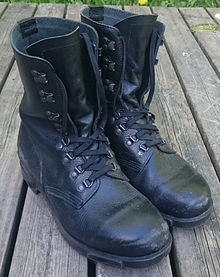
Norwegian M77 Boots by Alfa
The current combat kicking used past the Norwegian War machine is the M77. It was introduced in 1977 and is produced by Alfa Skofabrikk Every bit.[13] The M77 boot took ten years to develop and strict requirements were set for weight, durability, h2o resistance, comfort, besides every bit ease of maintenance and skillful heat resistance to facilitate quicker drying.[xiv] The Norwegian army oftentimes exam boots from other manufacturers, however they have not fabricated any plans to change boots for their soldiers.[14] The M77 kick has notches along the sole and in the heel made for the NATO issue skis used by the Norwegian Armed Forces. The bindings for these skis fit the M77 boots also every bit the thick waterproof outer shoes they can be put in. The boots can exist used for skis as well as snowshoes.
Sweden [edit]
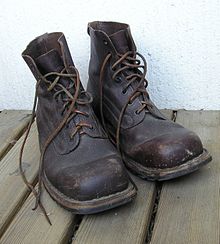
Swedish army boots made by Tretorn. These are NOS from 1968. Over time (and with the use of shoe polish) they turn black.
The war machine started using boots in 1779.[15] The electric current model is boot mod. ninety that is designed to be both comfy and light every bit well as giving ankle support. They are part of the UNI (Compatible) 90 combat compatible organization and are bachelor in a lighter summertime version and an insulated winter version with a heavier sole, designed for skiing, using Swedish standard army wood skies.
Switzerland [edit]
The Swiss Military machine use three models of combat boots. The KS (from the German Kampfstiefel) ninety, made from black leather and with a flat sole and used for marching on paved roads. The KS14 Schwer, fabricated by the Italian enterprise AKU, is a heavy duty gainsay kicking particularly designed for the Swiss Army but likewise sold to civilians, with metal inserts to protect the foot. Every soldier receives, at the first of boot army camp, 2 pairs of KS90 and one pair of KS14. Special Forces corpsmen are outfitted with another custom made boot, developed by the German Meindl for the Swiss Army, the KS08 Schwer AGFA. The KS08 is suitable for every environment, for parachute jumps and fast roping. It allows the mounting of crampons for rock climbing and, like the KS14, it has metallic inserts to protect the feet. The army will introduce new boots (KS19 and KS19 Schwer) in the near futurity.[16]
S Africa [edit]
Members of The South African National Defense Strength (SANDF) are issued brown combat boots with 18 lace holes, pimple impress leather and stitched rubber soles.
[1]
Paratroopers (Parabats) vesture a variant known as "Jumpers." These boots are taller, having 22 lace holes, and are heavier, due to the steel plate housed within their double soles. The steel plate prevents the human foot from flexing during hard landings when parachuting. They are usually polished with carmine polish. The colour combination of the dark-brown leather with the red smooth creates a shade of maroon that matches their maroon berets.
[2]
Special Forces (Recces) are issued tan half-gainsay boots known as "Waxies." These boots are an development of the onetime Rhodesian anti-tracking boots. The boots are ankle pinnacle, having 12 lace holes and an talocrural joint strap at the top which is fastened with a buckle. The leather is thin and breathable and has a smooth wax finish, hence the name. The boots are lightweight, and accept stitched safe anti-tracking soles. These soles are completely apartment, leaving backside shallow footprints that appear onetime and faded.
[3]
Singapore [edit]

The Singapore Armed Forces Combat Boots. Elevation to bottom: Army Combat Boot (ACB), Enhanced Gainsay Boot (ECB), RSN Combat Safety Kick, RSAF Gainsay Safety Kick.

The out-of-production Gore-Tex boots.
There are a few models of combat boots currently produced for Singapore War machine servicemen, namely the Army Combat Kicking (ACB), Enhanced Combat Boot (ECB), RSAF Combat Prophylactic Kick, and RSN Combat Safety Boot.
New enlistees are generally issued the ACB, of which there are ii variations, one manufactured by Wellco Peruana, a Peruvian brand, and another manufactured by Altama, a United States make. Both variations have a near-identical construction, with variations in quality. They feature a function-leather, part-material construction for breathability, straight molded soles, and two holes that allow drainage of any water that may take entered. The outsoles are designed to accommodate jungle environments.[17] These boots are similar in design to the U.Due south. Regular army hot conditions combat boots.
The ECB is the Spartan XTB by Magnum [4], and is issued to more combat focused units in the Singapore Army, such as the infantry, armoured infantry, guards, and commandos. It has a hybrid leather-fabric upper similar the ACB, simply with a lighter weight, fully stitched cupsoles, and an outsole design that is more than suited for both urban and jungle environments.[17]
Both the ACB and the ECB have been in use since December 2016.[17]
Past versions of boots issued within the Singapore Armed Forces include a total leather upper kicking with a reinforced toecap (in service until 1993), an improved version that removed the reinforced toecap, reducing weight, and had improved insoles that provided more support and offered better hygiene (in service 1993-2002), the 'Gore-Tex' boots, a revised design with parts of the upper made of Gore-Tex, making it waterproof (in service 2002-2012), and the 'Frontier' boots (named later the manufacturer), of which the Gore-Tex fabric was replaced with a porous nylon textile for quick drying, and featured water drainage holes, thus no longer making the boots waterproof (in service 2012-2016). The Frontier boots likewise had a redesigned sole that were supposed to give improved agility and condolement.[18]
The Frontier boots had received criticism from some Singapore Army reserve conscripts who were previously issued the Gore-Tex boots. Unlike its predecessor, the Gore-Tex boots, which were padded and waterproof, the Frontier boots did not feature the padding, and instead had an added ankle support strip, which some servicemen claimed made the kick more uncomfortable. The revised pattern as well lost its waterproof properties, which also drew criticism. However, it allowed water to drain out of the kicking afterward a river-crossing. Also, the kick became more ventilated and thus cooling with the revised design. Durability was also an issue in both the 2nd Generation Gore-Tex and besides some batches of the Frontiers. At times, the sole of the kick will come apart since it is only glued to the shell of the boot and not stitched. Some servicemen would also observe their Frontier boots' stitching coming apart after some weeks of usage, or even the soles disintegrating and cracking after prolonged use or storage. The succeeding ACB addressed the durability outcome with directly molded soles, and is also more comfortable.[17]
Not-aircrew servicemen of the Republic of Singapore Air Force are issued the RSAF Gainsay Safety Boots, manufactured past Borderland, for use in airbases. The RSAF boots feature padded sides, an outsole that is more suited to urban environments, a side-nil with a Velcro fastener, and a composite toe. Aircrew are instead issued the 800ST flight boots by Belleville that are waterproof, have a full leather upper, are steel-toed, and have a similar design to the U.Due south. Army temperate weather combat boots, albeit with different materials. [5]
The Commonwealth of Singapore Navy servicemen are issued the modified version of the RSAF's safe boots. The modifications include the two h2o outlets (similar to the Singapore Army's standard issue boots), and a reduction in height from a high-cut boot to a mid-cut.
Spain [edit]
Earlier 1979, the Castilian ground forces had issued triple-buckled boots, with full lace-up boots condign common from 1984 to 1986. During the 1980s Espana inverse boot suppliers and had many variations of pattern including Vibram or Panamá sole, buckles or laces, and eyelets or speed lace. There were 3 common models:
- Regular – The general-issue boot used for educational activity and campaign, it had a medium sole thickness and a few cleats. Smooth-soled versions barbarous into decay over time, leaving but the instruction and campaign model.
- Walking – A lighter-constructed version of the regular boot with no cleats. Information technology had a distinctive peculiarity equally a boot to article of clothing comfortably in the street, on flat ground, and was commonly known as vulgarmente (crude or vulgar) for its thin soles.
- Paratrooper – A boot exclusive to paratrooper units. It lacked the issue triple buckles (due to the run a risk of hooking the parachute lines), and was slightly higher with actress shin-to-pes support and reinforced toe and heel.
This was the general arroyo in the late 1970s and early 1980s. During this period the manufacturer, Segarra, had various major problems which prevented regular deliveries on their supply contract with the Ministry of Defence. This eventually led to Segarra'south closure, with Imipiel chosen as an alternative provider.
Imipiel-manufactured boots were copies of the Segarra models but proved to be inferior, with poorly-attached soles that opened and peeled-off with relative ease, greatly shortening their useful lifetime. In an attempt to overcome the debonding problem, Imipiel changed the outsole, removing the cleats, and incorporated "panamá" type soles.
The Ministry initiated parallel studies for the concluding adoption of a new model boot, accepting new concepts on the original kick of pedagogy and campaign and benefits of the paratrooper-styled kick.
United Kingdom [edit]
In late World War I, the standard Ammunition boots were replaced from 1917 to 1918 with the high-lacing dogie-length Field Service Boots for service in the trenches to combat trench foot.
The British Army introduced the DMS (Direct Moulded Sole) talocrural joint boot in 1958.[ commendation needed ] This had a moulded plastic sole and was externally similar to the World War Two Ammo Boot. However, as the leather was of shoddy quality at best, the boots leaked and could non be fabricated satisfactorily water-resistant. The low sideless tongue also allowed water to get in over the tiptop of the pes. Once water had got into the boot, information technology would evaporate through the top of the boot just not through the plastic sole, thereby keeping the foot wet and accelerating trench-human foot. Although mesh insoles were issued to gainsay this, they were themselves fragile and could lead to 'burning' of the sole of the pes,[ citation needed ] with the result that well-nigh soldiers used commercially available sports-shoe insoles instead. This blazon of boot continued in service until the mid-1980s, after its unsatisfactory characteristics became a matter of public business organisation attributable to the severe cases[ commendation needed ] of trench-foot incurred during the Falklands State of war. The DMS boot was worn with anklets or wind-around puttees.
The immediate successor of the DMS kick was the "Boot, Gainsay High" – or as the soldiers themselves described it, the Boot Cardboard Horrible. Basically little more than a toecapless DMS kicking extended up to mid-calf length, it was scarcely better than its predecessor. Theoretically waterproofed, it was therefore sweaty and unpleasant, and could crusade acute tendinitis. A MkII version was introduced to solve this, just institute little favour. Its only existent reward was that it was not supposed to be 'bulled' to a mirror polish.
The Gainsay Attack Boots (CAB) were electric current issue until 2012, and were used primarily for combat training and general service although privately purchased boots were ofttimes accounted acceptable as long every bit they are made of blackness leather.[ citation needed ] The Foot Guards even so utilise modified armament boots. These boots, existence primarily made of leather, can exist brought to a high smooth for the ceremonial purpose, although boots used as every-solar day armed services footwear tend to exist left comparatively dull, only clean.
Various levels of smooth can be achieved with CAB. However, when on practice (in the field) or on operations, soldiers are only required to shine their boots to combat high.[ citation needed ]
Jungle boots supplied by various manufacturers are also ordinarily worn in barracks due to the ability to carry out loaded marches faster and for longer.[ commendation needed ]
From 2012 Armed Forces personnel will have a newly designed range of chocolate-brown combat boots to supervene upon the black and desert combat footwear they currently habiliment. Personnel will have the choice of five different boots depending on where they are based and what part they are in.
- Desert Combat – worn by dismounted troops conducting medium to loftier levels of action in desert type environments with temperatures exceeding forty degrees Celsius.
- Desert Patrol – worn by drivers/armoured troops conducting lower levels of activeness in desert type environments exceeding 40 degrees Celsius.
- Temperate Combat – worn by dismounted troops for medium to high levels of activity in temperate (European) climates.
- Patrol – worn by mounted troops (drivers/armoured troops) taking part in lower levels of activeness in temperate (European) climates.
- Cold Wet Weather – worn by dismounted troops for medium to loftier levels of activity in temperatures down to –20 degrees Celsius.
Each of the five boot types comes in two different styles, so personnel can article of clothing whichever 1 is more comfy for them. The new brown boots, which have been adult to match the MTP uniform worn by Service personnel, will be made in two dissimilar fittings designed for the showtime time to accept account of the dissimilar shapes of men's and women'south feet. The electric current black boots volition behave on to exist worn with nearly non-camouflage uniforms as well as by units on parade in total apparel compatible, such as regiments performing ceremonial duties in central London.[19]
As of 2018, the v categories previously issued, have been changed to simplify the choices available. The Italian manufacturer AKU now supply their Pilgrim model as an option for a high liability boot aslope Altberg.[20]
United states [edit]
The 1917 Trench Boot was an adaptation of the boots American manufacturers were selling to the French and Belgian armies at the beginning of World War I. In American service, information technology replaced the Russet Marching Shoe. The boot was made of tanned cowhide with a half heart sole covered past a full sole. Iron plates were fixed to the heel. It was a great improvement, however it lacked waterproofing. It before long evolved into the 1918 Trench Boot, also called the Pershing Kick after Full general John Pershing, who oversaw its creation. The boot used heavier leather in its structure, and had several minor changes from the 1917 Kicking.
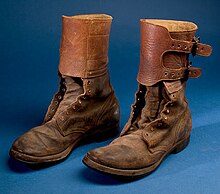
M-1943 Combat Service Boots.
The first true mod combat boots in the United states Army, officially titled "Boots, Gainsay Service", were introduced in conjunction with the G-1943 Uniform Ensemble during World State of war II.[21] [22] They were modified service shoes, with an extended, rough-out or, more unremarkably, a smooth leather high-top cuff added.[21] The cuff was closed using 2 buckles, allowing the boots to supersede the existing service shoes and leggings worn past most soldiers with a more convenient and practical solution.[21] The boots, and the service shoes from which they were made, had a one piece sole and heel, made from molded synthetic or reclaimed rubber.[21] [22] [23] These "double buckle" boots were worn through the Korean State of war as a substitute for the Boots, Russet, Leather Lace Upward introduced in 1948. The first type of Combat Boots, or Combat Tropical boots were based on the "buckle boot" design and worn during the early parts of the Vietnam War.[24]
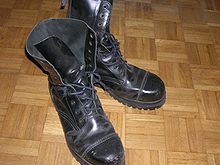
Boots similar to the older IDF combat boots

U.S. Regular army soldiers are issued their boots
In 1957, the The states Regular army switched to shined black combat boots, although the transition to black boots was not completed until late in the Vietnam War, which also saw the introduction of the jungle boot.[3] [24] [25] Both of these boots had a direct molded sole.[26] The jungle boot had a black leather lower and an olive drab sail (later nylon) upper.[27] Blackness boots continued to be worn following Vietnam, with the M81 BDU, although non-shine boots were considered past the Army.[3] [28] [29] [xxx] As the BDU was replaced with the MCCUU, Army Combat Uniform, and Airman Battle Compatible the services moved to more practical, not-smooth footwear.[3] [31] The only electric current armed services service mandating shined black combat boots are the United States Naval Bounding main Cadet Corps, the Auxiliary Buck Disengagement of the Naval forces, and the Ceremonious Air Patrol, the Auxiliary of the U.S. Air Force, in conjunction with the BDU utility compatible.[32]
As the United States Marine Corps made the transition from its utility compatible to the MCCUU, they discarded shined black combat boots, and switched to more functional tan rough-out (not-shine) combat boots, with either hot weather or temperate weather versions. The standard-issue boot is the Bates Waterproof USMC combat boot. Commercial versions of this boot are authorized without limitation other than they must be at least 8 inches in height and bear the Eagle, Globe, and Ballast on the outer heel of each boot. Beginning on Oct i, 2016, Marine Corps personnel were authorized to wear various Marine Corps Combat Kick models from Danner, Belleville, McRae and Bates, and Rugged all-terrain boots from Danner.[33]
The U.s.a. Army followed suit in 2002 with the introduction of the Regular army Combat Compatible, which too switched to tan crude-out combat boots, called the Ground forces Combat Kick, and cotton socks.[1] [3] Commercial versions of this boot are authorized without limitation other than they must exist at least eight inches in height and are no longer authorized to have a 'shoe-like' appearance.[34] Ii versions be, a 2.v lb temperate weather condition kick, and a 2 lb hot weather condition (desert) boot.[1] Current manufacturers include (but are not limited to) Altama, Bates, Belleville Kick, McRae, Rocky, Warson Brands/Antipodal and Wellco.[1]
The U.s.a. Air Force uses a sage dark-green suede combat kicking with its Airman Battle Uniform, although a tan version was authorized until 2011, when the dark-green kicking became mandatory.[35]
Style [edit]
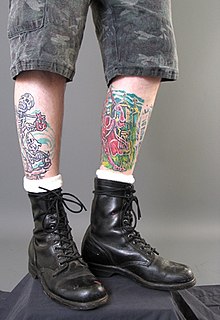
Combat boots worn every bit way apparel.
Gainsay boots are likewise popular as fashion article of clothing in the goth, punk, grunge, heavy metal, industrial, skinhead, and BDSM subcultures, and as piece of work boots; nonetheless, they are becoming more and more mainstream.[36] Beyond fashion every bit such, many individuals choose to habiliment gainsay boots simply due to immovability, comfort and other utilities, as the boots are specifically designed to exist comfortable to clothing in a variety of irresolute conditions for long durations without significant long-term habiliment. Combat boots have a longer lifespan than fashion boots, which can give them a vintage feel, even after recrafting. For these and other reasons, they can be purchased at military surplus stores.
See also [edit]
- Cold conditions kick
- Desert Combat Boot
- Jackboot
- Modular Boot System
- Mountain Combat Kicking
- Tanker boot
- Jungle kick
References [edit]
- ^ a b c d "Building a Better Boot" – via Scribd.
- ^ The Logistics of War. DIANE Publishing. p. 318. ISBN978-1-4289-9378-five.
- ^ a b c d eastward Tanner, Jane (2001-12-09). "GRASS-ROOTS BUSINESS; On the Home Front, a Welcome Economic Kick". The New York Times.
- ^ Summer, Graham; D'Amato, Raffaele (17 September 2009). Arms and Armour of the Royal Roman Soldier. ISBN9781848325128 . Retrieved 2015-eleven-05 .
- ^ Graham Sumner (2009). Roman Military Dress. History Press. p. 191,193. ISBN9780752445762.
- ^ "Defense force gives SA-made shoes the boot for imports". 13 July 2014.
- ^ "Бельгийские военные ботинки конца 1960–х – середины 1990–х". cartalana.com.
- ^ Les rangers remplacées par chaussures Meindl
- ^ a b Dutta, Amrita Nayak (August 3, 2018). "Indians supply modern combat boots to US army, simply our soldiers use '130-year-old' designs". The Print.
- ^ "Leather Division". Ordnance Equipment Factory Kanpur.
- ^ Brig CS Thapa (7 August 2014). "Foot Wearable for the Soldier". Indian Defence force Review . Retrieved 2018-08-03 .
- ^ Tiwari, Shivam (2017-04-08). "This development of DRDO's will salve countless Indian Ground forces'southward soldiers lives". DefenceLover . Retrieved 2018-08-03 .
- ^ "М/77 – Ботинки вооруженных сил Норвегии". cartalana.ru.
- ^ a b "Salutt til gammel sliter". norskdesign.no. Archived from the original on 2011-07-sixteen. Retrieved 2011-01-11 .
- ^ "Nordiska museet: Skor" (PDF). Archived from the original (PDF) on 2007-10-30. Retrieved 2008-06-07 .
- ^ "Versuche und Entwicklung".
- ^ a b c d hermes (2016-12-27). "More rugged combat boots for SAF soldiers". The Straits Times . Retrieved 2021-07-x .
- ^ hermesauto (2016-12-27). "How the SAF'southward gainsay boots have evolved over the decades". The Straits Times . Retrieved 2021-07-ten .
- ^ "Deal signed for new gainsay boots". mod.uk.
- ^ "AKU pilgrim review". xiii July 2018.
- ^ a b c d "WW II Combat Boots". olive-drab.com.
- ^ a b "Shoes and the Army – WWII". regular army.mil.
- ^ Stanton, Shelby 50 (1995). U.Southward. Army Uniforms of World State of war Two. Stackpole Books. p. 241. ISBN978-0-8117-2595-eight.
- ^ a b Katcher, Philip R.N.; Mike Chappell (1980). Armies of the Vietnam War, 1962–75: Bk. 1. Osprey Publishing. p. xiii. ISBN978-0-85045-360-7.
- ^ Rottman, Gordon L.; Ronald Volstad (1990). U.Southward. Army Airborne, 1940–1990: The First 50 Years. Osprey Publishing. p. 59. ISBN978-0-85045-948-seven.
- ^ Park, Alice F; Swain, Douglas Due south (1967). "Directly Moulded Sole Boots" (PDF). dtic.mil. Technical Report 68-20-CM. Habiliment and Materials Laboratory, United States Army Natick Laboratories.
- ^ "Jungle Boots". olive-drab.com.
- ^ "NO-SHINE COMBAT Kicking IS Failing Regular army TESTS". The New York Times. 1981-11-12. p. A23.
- ^ "SHINING'Southward OUT IN Army Test OF NEW Kick". The New York Times. 1981-06-thirteen. p. A8.
- ^ Stanton, Shelby L. (1998). U.Southward. Army Uniforms of the Cold War, 1948–1973. Stackpole Books. p. 148. ISBN978-0-8117-2950-v.
- ^ Halberstadt, Hans (2007). Battle Rattle: The Stuff a Soldier Carries. Zenith Imprint. ISBN978-0-7603-2622-0.
- ^ (PDF) https://web.annal.org/spider web/20110717002603/http://www.thehock.com/CAPM%2039-1.pdf. Archived from the original (PDF) on 2011-07-17. Retrieved 2011-01-28 .
- ^ Schehl, Matthew L. (2017-08-07). "Marine Corps refines list of canonical combat, RAT boots". Marine Corps Times . Retrieved 2018-04-30 .
- ^ "Army Combat Uniform (ACU) Ensemble" (PDF). Archived from the original (PDF) on 2009-02-27. Retrieved 2008-01-17 .
- ^ Air Force Didactics 36-2903
- ^ Hochswender, Woody (1992-06-28). "SIGNALS; Your Sis Wears Combat Boots". The New York Times.
External links [edit]
![]() Media related to Combat boots at Wikimedia Eatables
Media related to Combat boots at Wikimedia Eatables
0 Response to "Combat-style Rugged Sole Buckle Detailed Mid-calf Fashion Boots"
Post a Comment